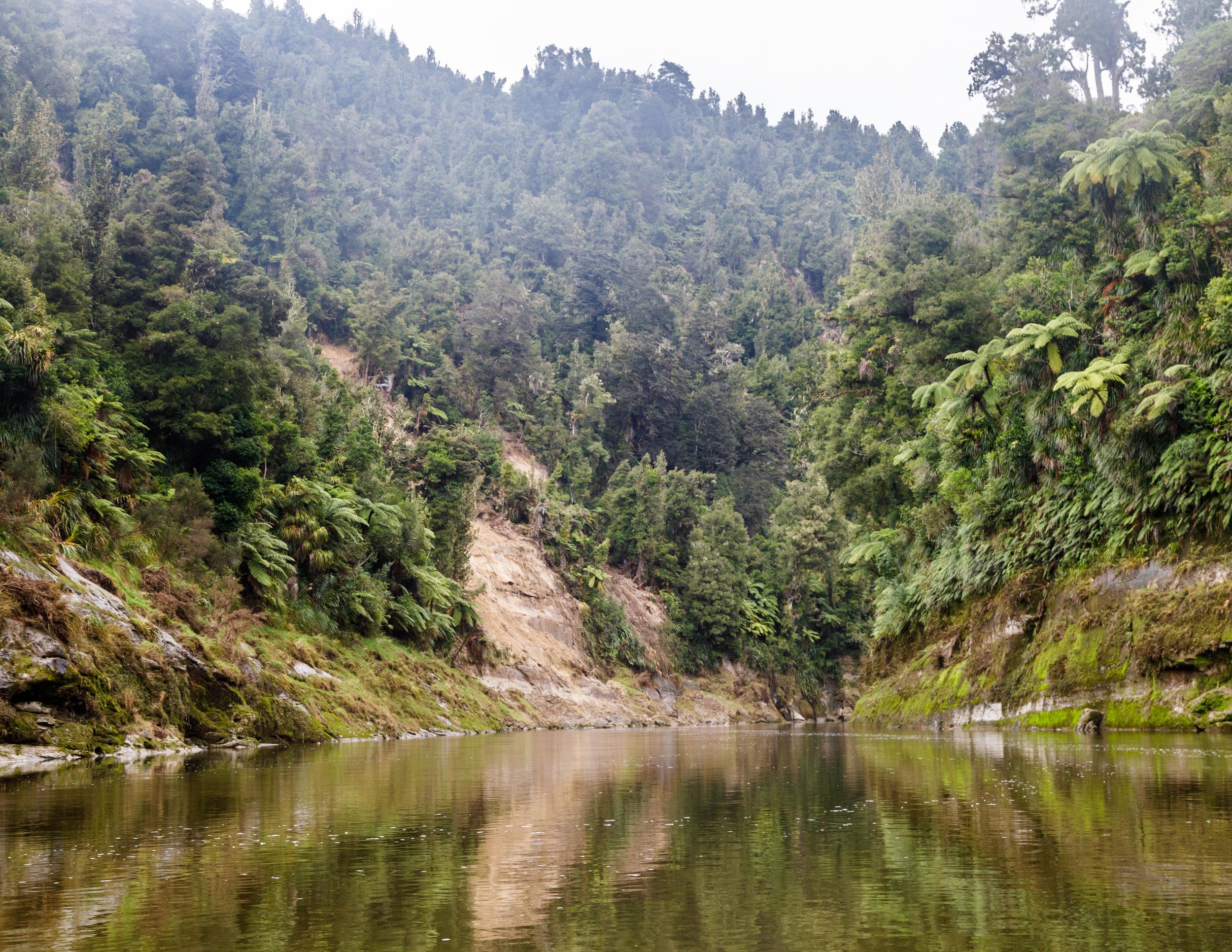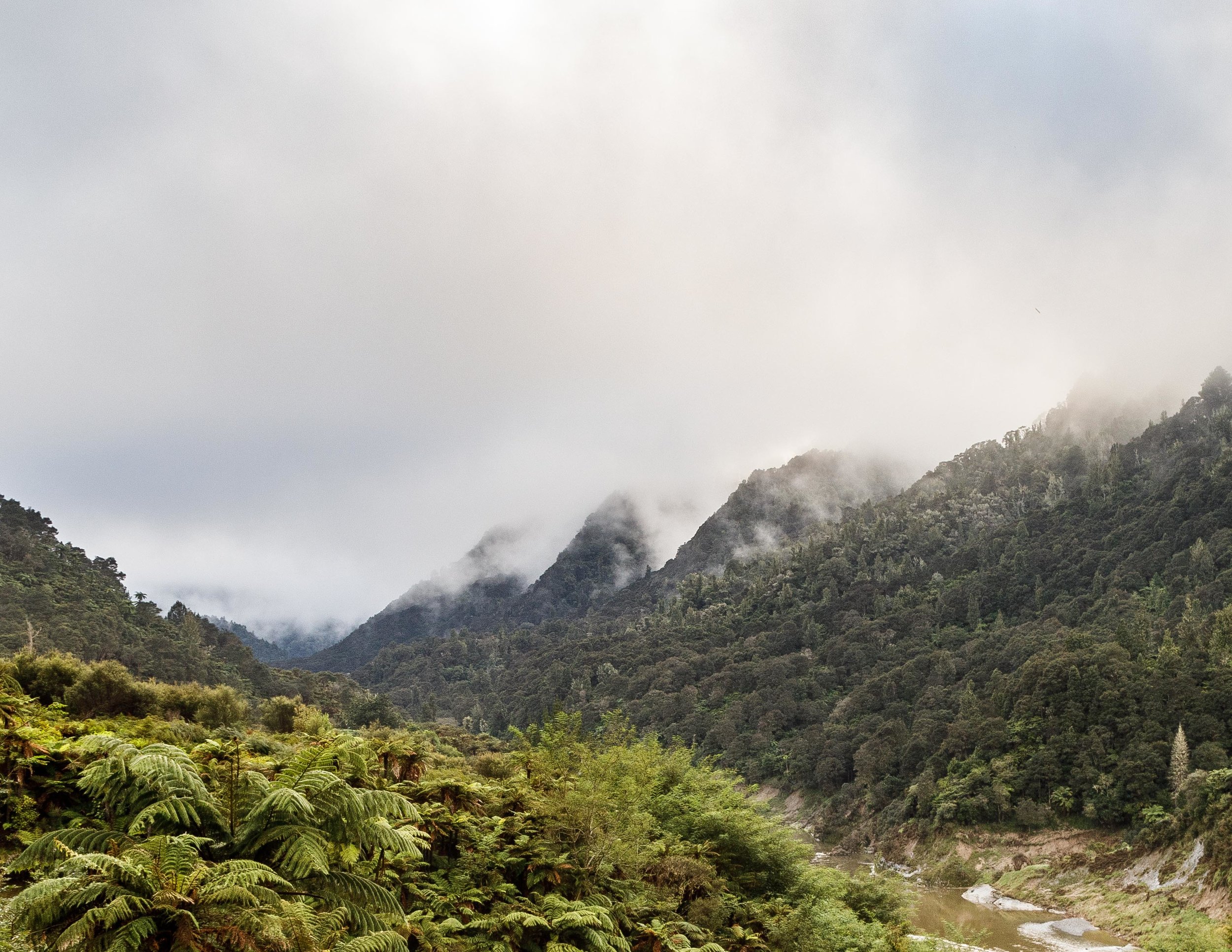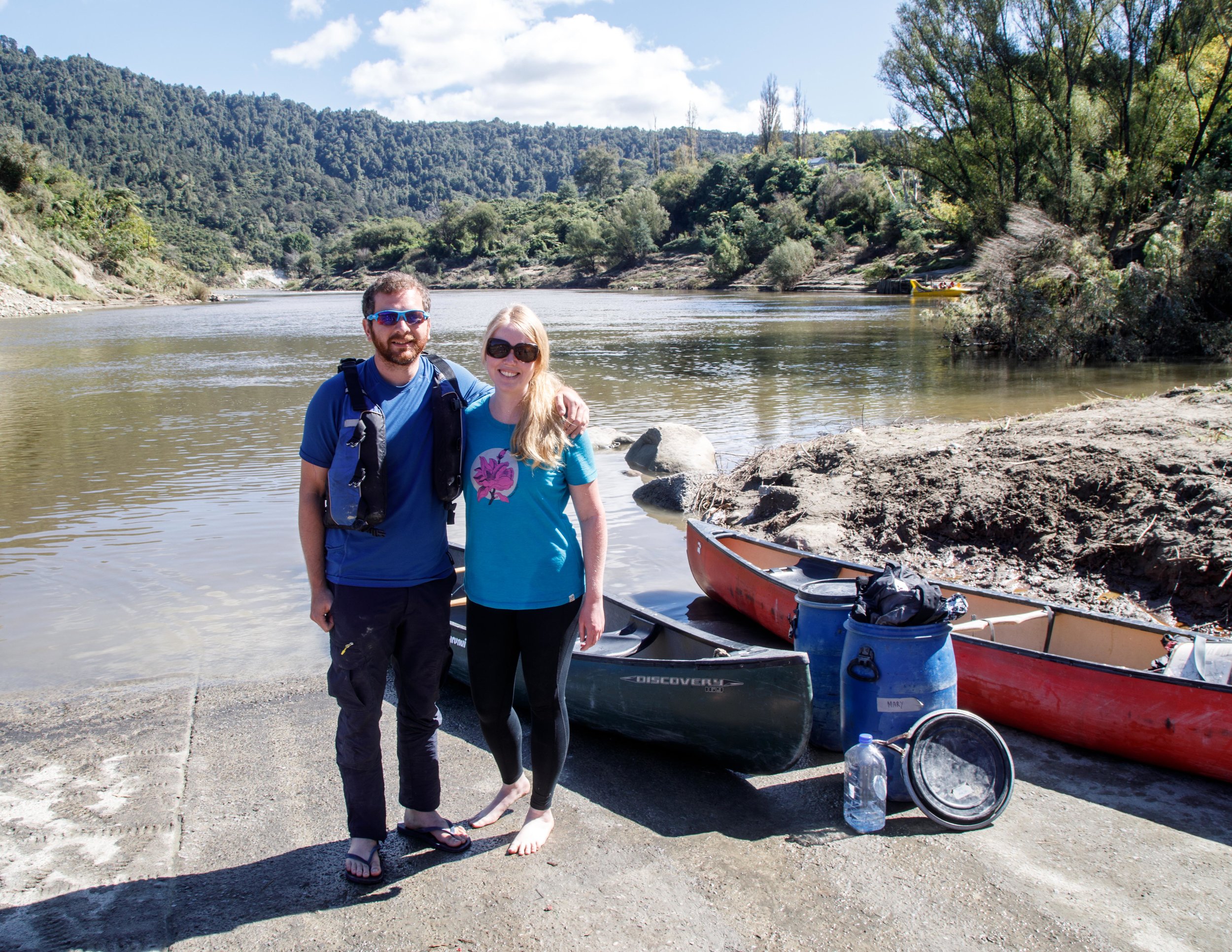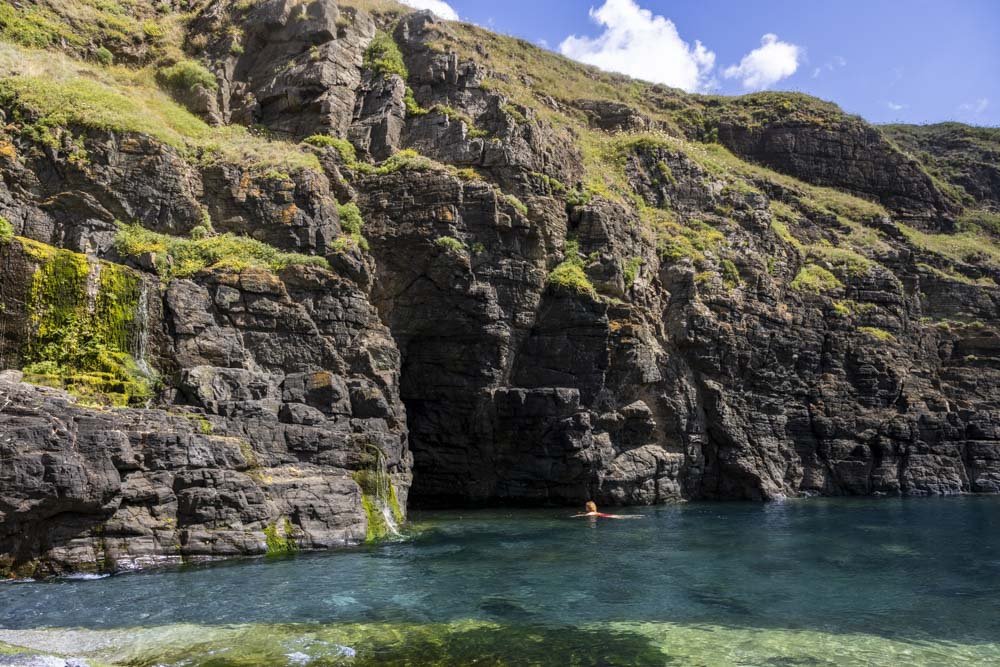Yep, only in New Zealand could one of the nine Great Walks of New Zealand actually be a canoeing trip! Before embarking our 9 Great Walks in 9 Weeks challenge, this was the one that had us a bit concerned. We walk a lot, but we've barely ever canoed - in fact the longest canoe trip we had done to date was 5km. 140km short of the Whanganui Journey!
However, a challenge is a challenge, so canoe we must. Overall the "walk" is five days long and involved at least five hours of canoeing most days with quite a few rapids along the way. On paper, it looked pretty tough, especially as we have virtually no upper body strength. We were also more than a little apprehensive about certain rapids, including the aptly nicknamed 50/50. Yes, you guessed it, 50% chance you will get tipped out the boat. We were pretty sure this would be us.........
When contacting the boat hire company we were asked about our canoeing experience. On hearing it was virtually zilch, they advised us to skip the first two days which contained the majority of rapids. Skip two days of the Great Walk? Never! We promised we would practice a little, and then promptly forgot all about this plan.
Day 1: Taumaranui to Ohinepane
Distance: 22km
Time taken: 3.5 hours
Conditions: Fast flowing water, a couple of evil rapids and one near tip
A pretty poor start
We woke up with the anticipation of making an early start, hoping to get to the river in the morning to be able to learn the ropes and be prepared for what was coming. Prepared was hardly the word to describe us.
We hopped in the car and started making our way from Raetihi to Taumaranui and soon found that we had jumped in without seeing the safety briefing. Luckily the rep from the canoe company had an iPad where we could watch on our way.
The start of the Whanganui Journey: Taumaranui
Our second fail was that we soon found out from watching the video that there was no toilet paper at any of the camp ground or huts (something we hadn't experienced on any other track to date). A quick diversion to New World Supermarket and we carried on to the start of the river.
It was mid-safety briefing that I realised our bottles of water hadn't come with us. This prompted our rep to take us back to the supermarket again to stock up. To say we felt sheepish was an understatement. I was beginning to fear he would consider us far too hopeless to embark on this journey!
A long safety briefing
Having remedied all three failures, we soon got into the safety briefing. By now it was about 11am, at least two hours later than the anticipated start time!
Seeing that we clearly didn't know what we were doing, our rep decided that a long safety briefing was needed. We soon got told about almost every rapid in the river, what to do with them, options for avoiding them, and a couple of references to potential impending death. A talk that had us question why on earth we'd signed up for this. Much was made of the three large rapids on day five, the nervousness grew further in our minds.
None of this was made any better when we were told that there had been a recent huge flood no the river that had caused all kinds of damage. The river had risen 10 metres in the space of 24 hours, causing all untold damage and stranding quite a few people along the way. Although the river levels had dropped, there were landslides, driftwood and trees that were now in the middle of the river. Large debris were causing new rapids. Yikes.
The river had changed so much that he called us pioneers, paddling through a place that few others had been through in its current state...
An hour later - having gone through every minute detail about the peril we were facing - we were taught how to actually paddle! Five minutes later and we were onboard, scared to death about what we were going to face.
Taking on the river
The Great Walks guide's description of day one is pretty concise, basically describing it as a day of rapids. This is pretty accurate and we were thrown into the deep end. Within the first four bends we faced two of the most turbulent rapids of the whole canoe ride, armed with a five minute talk on how to paddle.
Unbelievably we only came out of it soaking wet, but still in the canoe. It had been touch and go, and we'd had a very near tip. Having been told about the precarious three rapids on day five we weren't feeling too optimistic.
The day seemed to go well though. The river flowed fast and, although there were a lot of rapids, most were the type that bump you a little and threw you along, However, we soon learned about the dreaded Eddy.
For those who don't know (I was one of them), a lot of rapids have a side of the river that flows in the opposite direction. These are called "eddys" and we kept finding that rapids loved to start by pushing you down river and then spin you round by throwing you into an eddy. Paticularly bad canoers (yours truly) can go into a rapid pointing forward, spin backwards in an eddy and then go back into the rapid, hurtling down stream in reverse.
Mid-paddle bliss
In between rapids we had plenty of time to stop and look at the scenery. We were paddling through a mixture of farmland, which reminded us strongly of Hobbiton, and bush. It was very pretty. On day one and two of this journey there is a road running beside the river, though you almost never see or hear it.
Within a couple of hours we soon saw a sign for a coffee shop. Only one other Great Walk has a coffee shop mid-way through the track, and it's bliss (take note DOC).
Having moored the canoe, and said a quick prayer that it didn't drift away, we walked up the stairs to a beautiful lavender farm and coffee shop. Like a kid in a candy shop we ordered everything, coffee, cake and anything else I could think of (believing this would be the last piece of civilisation we'd see for five days). Sadly they didn't take foreign credit cards and we only had $10. So a cup of tea and cake to share it was... oh the devastation.
Still, the sun was out, we were in the countryside and didn't have to haul a heavy backpack. Maybe there was something to be said about this canoeing lark.
Ohinepane campsite
Within an hour of getting back in the canoe we were at our stop for the night: Ohinepane campsite. Yep, the first two nights of this Great Walk were spent in a tent, another reason why I wasn't initially a big fan. However, we quickly noticed that we were sharing the whole campsite with only a German couple and five chickens. It could be worse.
Sadly this soon changed as after the sun went down several camper vans and cars turned up out of nowhere. Sadly this was a campsite with road access so our little private haven was no more. We also didn't clock that camping next to chickens meant we had a rather early alarm call.
Day 2: Ohinepane - Whakahoro
Distance: 35km
Time taken: 5.5 hours
Conditions: Fast flowing water, evil rapids again
Up early
You guessed it, that rooster went off and decided that 4am was the optimal time. Bizarrely enough our countryside campsite had the really loud noise of a dog barking every three seconds all night, something I hadn't heard since the rabid/feral/stray dogs in Asia.
The morning mist at Ohinepane Campsite
We soon had brekkie, packed up the site and got back in the canoe. After the first day our arms were wondering what had hit them, but soon got back into the motion of paddling again.
The river decided to throw in a pretty evil rapid straight away (literally just moments from the campsite). We took it in the worst way you could: grounding ourselves a couple of times and spinning in the eddy, floating downstream in reverse. We couldn't have done worse if we tried.
However, we were still in the canoe (small victories) and carried on downstream with the river taking us at a good speed. The landscape carried on just like day one, meandering through bush and farmland that sat quite a lot higher than the water. The sun stayed out and between rapids things were nice.
We almost died
Within a few hours we pulled over at a shingle beach to have some lunch. Unloading the barrels, we tucked in. We soon found out that the Whanganui sandflies had clearly been waiting for us and were relishing a fresh meal. Ten bites later and we'd had a very speedy lunch, returning enthusiastically to the canoe.
Remember how we were warned about no one knowing what the river was like right now? Well we can tell you that the last part of day two is just carnage after the flood. Not only had half the banks of the river turned into mud slides, but the river was now full of trees that stuck high out the water.
The Whanganui Gorge
The worst thing about this is that rapids flow around rocks, so you can often take the flow of the river and avoid the obstacle. However, rapids can flow through the branches of trees and one particular section did just this.
Following the deepest part of the river, the rapid then took us with alarming force into a tree that had lodged in the river. We were soon paddling like our life depended on it, managing to hit the first tree with just the canoe, and bouncing us back into the river.
It then dragged us into another much more dangerous one that had a thick branch that could impale those who followed the flow of the river. Everything went into slow motion as we were hurtling towards the tree that was set to skewer us.
Luckily we managed to avoid it at the very last moment, but it was a deadly situation for two novice canoers to be thrown into. It took a long time for the heart beat to return to a normal rate.
Devastation and relief
We soon got to Whakahoro where the full extent of the flood had hit. The canoe landing had disappeared, leaving a small mudflat to moor the canoe. There were trees and rocks everywhere and you literally had to climb up the mud slide.
To add insult to injury, the campsite was 400 metres up a hill. Due to the amount of barrels we had, it required two return trips to bring everything up after a pretty tiring day. We also saw a hut, something that did not appear of the DOC brochure information, so we had booked the campsite.
One of the slips caused by the recent flood
But then we spotted bliss once more: a cafe that also offered hot showers. A strong coffee and a shower later (one of the best $4 we have spent on this trip), and we began to feel a lot better.
Day 3: Whakahoro - John Coull Hut
Distance: 37.5km
Time taken: 5.5 hours
Conditions: Slower river, a lot of paddling and only a few little rapids
Near death situations - 0 - progress
Leisurely down river
After a brief rainstorm in the morning, and a big breakfast at the nearby cafe, the last taste of civilisation before entering the national park, (only accessible by boat, on foot or on bicycle), we jumped back into the canoe. Our thoughts revolved around thinking we had three more days to go and had already nearly been tipped in turbulent rapids and skewered by a tree.
Backwards through the whirlpool
Once we were back in the canoe it all got a lot easier. We soon entered the national park, where the grassy hills were replaced by forests and gorge. At points the river felt like paddling on a lake, completely still with no assistance. That was until you hit the whirlpool. The whirlpool aims to drag you into the nearby cave, we were lucky enough to resist, although we did get spun backwards, where we moved at speed hoping and praying there was nothing to spear us. We thought this was a less than successful whirlpool encounter until we saw a fellow canoeist lose their oar and have to dive in to save it!
The river then became fairly placid again for the remainder of the day. There were rapids but far fewer than on the first two days. This allowed you to fully relax and enjoy the gorgeous scenery, after the rain there were many waterfalls running down the cliff sides. It did mean that paddling became harder work though, as the water was so still it felt like you were shifting soup!
It was definitely the day that we felt like we hit our stride and powered by the big breakfast managed 5.5 hours of canoeing without even stopping for lunch!
Arriving at the hut
We arrived at John Coull hut just as the heavens opened. We once again moored up on a recent land slide and traipsed up to the hut. The hut was an older style one and had just one bunk room for everyone to sleep in. There had been less than subtle murmurings about a champion snorer in the ranks, so we were a little concerned by the lack of escape options!
After spending most of the afternoon chatting with our fellow paddlers, and eating yet another pesto pasta dinner, we decided that we might actually prefer another night in the tent to a night in snorerville. However, after setting it up the heavens opened again and we decided to stick to the original plan!
Day 4: John Coull Hut - Bridge to Nowhere Lodge
Distance: 29km
Time taken: 5 hours
Conditions: Very slow, virtually no rapids
Back in the canoe
After a surprisingly good night's sleep (barely a single snorer - win) we had an early brekkie and got into the canoe once more. It was gloomy outside and within 15 minutes the rain was back.
Rain during a hike is a little bit annoying. Rain when canoeing is a bit more demoralising, especially on a day when the river barely moves. You simply sit and paddle whilst getting pelted with rain and the canoe fills with freezing cold water. At this point we were both a little bit over the novelty of paddling rather than walking.
After two hours of constant rain, we made it to the landing for the Bridge to Nowhere, it's a 45 minute walk each way to the bridge. Frustratingly, there's only a tiny but very steep and slippery landing for canoes, meaning you have to do some balancing and acrobatics to simply get up to the path. As the rain continued to sap our morale, we put our wet hiking boots on and started to walk.
The Bridge to Nowhere
The Bridge to Nowhere is a structure that was built as a grand idea. After the Second World War, the New Zealand government had the idea of giving the returned servicemen some land near the Whanganui River. To make this accessible, they planned to build a road to Taranaki, winding over rivers and up hills.
The Bridge to Nowhere
What they soon found is that the deforestation needed for the road, land and farms would caused unliveable landslides and erosion. Although the bridge was built, life became impossible and soon the residents abandoned the area Hence the name: The Bridge to Nowhere.
After a short time, the rain stopped and within twenty minutes we'd reached this peculiar spot. You could see eels swirling in the river below, hoping for tourists to drop some food down. After a short look around (we quickly realised that it was only a bridge) we headed back to the boat to find the sun had come out for the first time in a couple of days.
Plowing on
After a quick stop for lunch (very quick, those sandflies are just about everywhere and vicious) we ploughed on for the highlight of the trip accommodation: The Bridge to Nowhere Lodge. Anticipating that four days of mud, huts, camping and canoeing would leave us tired and dirty, Cat spotted a lodge we could stay at on day four.
It was a stunning haven and sight for sore eyes, despite having the world's worst, mud filled path uphill before arriving. After ditching all footwear and getting covered in mud, we arrived to absolute bliss: comfortable beds, hot showers, tea and coffee and Cat's favourite - home made banana and chocolate muffins. You could even buy a glass of wine. The rain came down again but this time it was soothing to watch over a steaming cup of tea.
Day 5: Bridge to Nowhere Lodge - Papriki
Distance: 21.5km
Time taken: 4 hours
Conditions: Some brutal rapids
Fearing what was coming
So day five was the one we were told to watch out for. After a few days of tranquil water, the Whanganui River would build to three triumphant rapids. After surviving for four days, we grilled every man and their dog about what to do in these monsters.
The start of day 5
After a big breakfast at the lodge, we hopped back in the canoe for a couple of hours paddling where the biggest obstacle was the hundreds of jet boats creating turbulence in the water. It was Good Friday and the number of people on the river grew substantially.
However we soon got to Ngāporo campsite where the first of the dreaded rapids was meant to be. We pulled up to the camp to talk to the others to see what they were going to do about the rapids and the best tactic for not abandoning ship. What we found out was that we had actually unknowingly rowed around the worst of it already! Maybe all this talk of rapids was all just a storm in a teacup.
We soon found that all of the dreaded rapids were in a really wide stretch of river and did not seem to be as bad as their reputation suggested! By now we had an eye for finding the best route to avoid being chucked out the boat and we soon found that we had passed through the second evil rapid when we saw a couple of canoers in the water with their canoe upside down. Cat had initially pointed out the big birds in the distance, only to realise they were actually our fellow paddlers!
However our luck soon turned as we tried to avoid what we thought was a dead-end (it wasn't) and soon got beached in the middle of a very shallow part of the river. For fifteen minutes we both tried to paddle, push, pull and rock the canoe from the boulders it was wedged on, seeing everyone else cruise by. Other boats stopped to see if we were ok but there was no way of getting any help or they would be beached too! The boat rocked back and forth amongst the rapids and we were both convinced this would be our tipping moment. I resorted to hitting rocks in the hope we would dislodge. Stepping outside the canoe I rocked it a couple of times and jumped back in as we soon flew back down river again, with a sore and bloody foot for my efforts.
Happiness at Pipriki
Fifteen minutes later we could see the end and casually paddled the last rapids, relieved that we'd finished, dry and intact. It was a unique experience, and probably not one we would have had, were it not for the fact it was classified a 'Great Walk'. Who knows, we might even try it again one day!
How to plan the Great Walks
North Island
South Island
This post may contain affiliate links, meaning at no additional cost to you, that we will earn a small commission if you click through and decide to make a purchase. This helps towards the costs of running our website. :-)
Like it? Pin it!
Have you canoed the Whanganui River? Did you tip in the 50/50? Let us know in the comments below.








How to find one of Cornwall’s most magnificent rockpools, Ray Pool, as well as how to visit safely and what to expect from the trail.